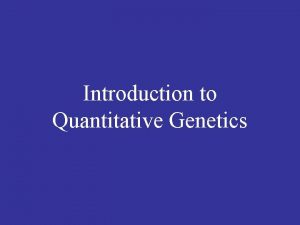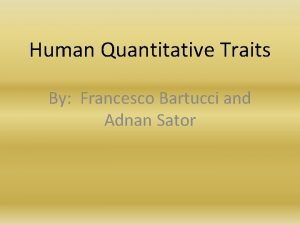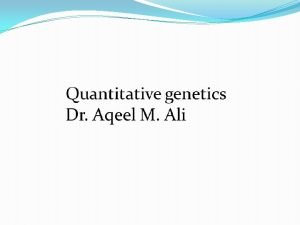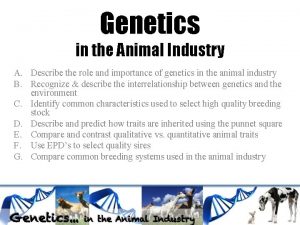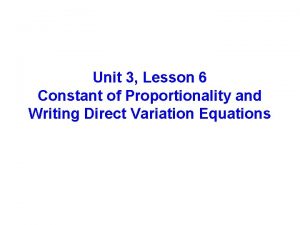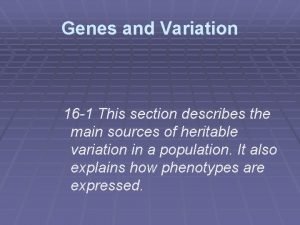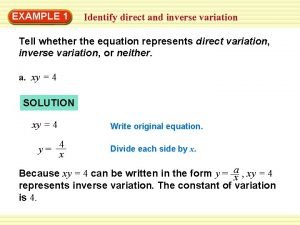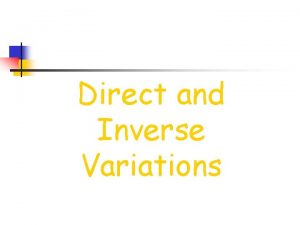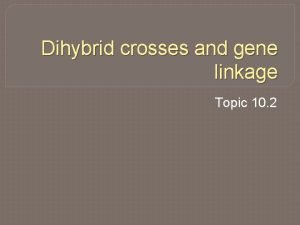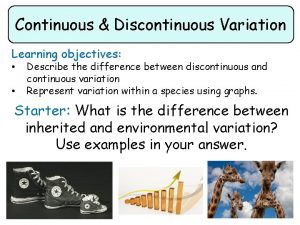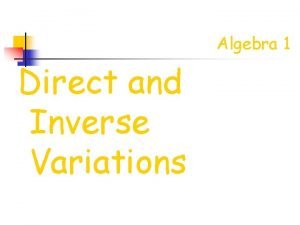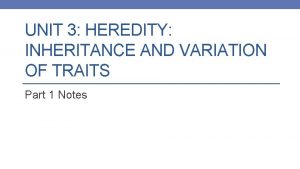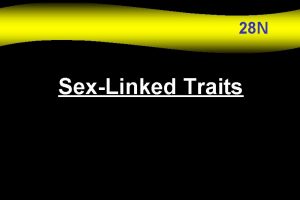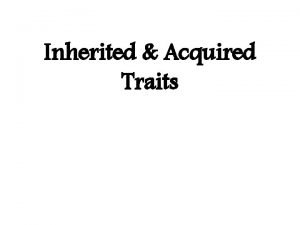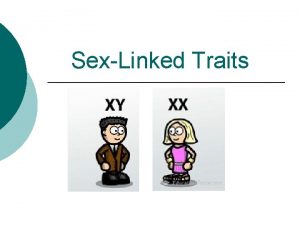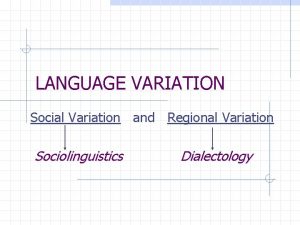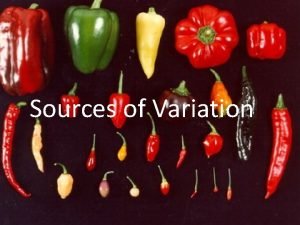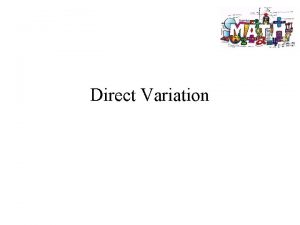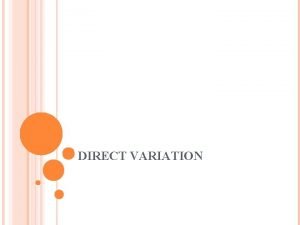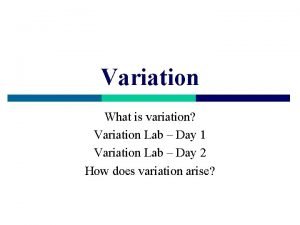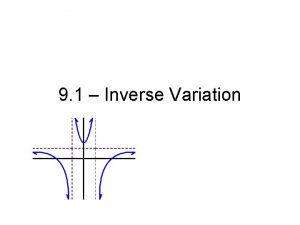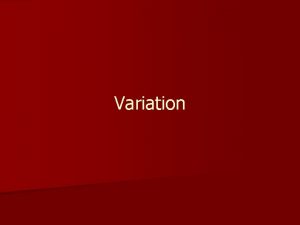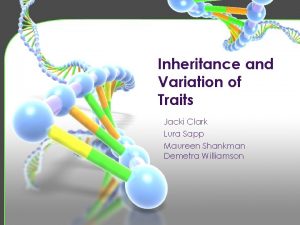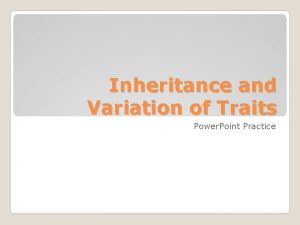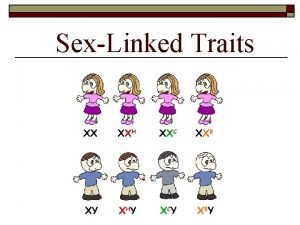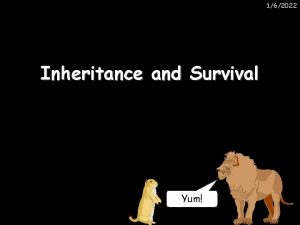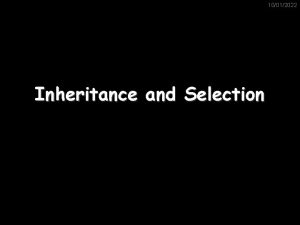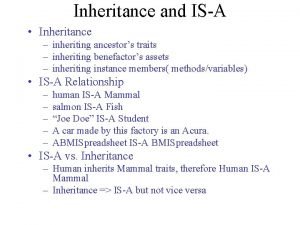Inheritance and Variation of Traits Unit 6 INHERITANCE






















- Slides: 22

Inheritance and Variation of Traits Unit 6

INHERITANCE ⦿A trait is a distinguishing characteristic of an organism. ⦿ During reproduction, traits are passed down from one generation to the next, this is known as inheritance. ⦿ For every organism there is a range of inherited traits. � Hair color � Eye color � Petal color � Attached earlobes Can you name more?

INHERITANCE (COPY ENTIRE SLIDE) ⦿ Not all traits are inherited. ⦿ An acquired trait is a trait that an organism acquires or develops during his lifetime. �Losing a limb (arm/leg) �Learning a trick/sport �Neat handwriting �Growing long hair Can you name more?

GENES, DNA & CHROMOSOMES …OH MY! ⦿ Gene – a section of DNA that has genetic information for one trait ⦿ Genes produce proteins that affect each trait ⦿ DNA – (Deoxyribonucleic Acid) contains genes DNA appears as a twisted zipper in the nucleus; when stretched out can be almost 2 meters long! It can fit into a cells nucleus since it is tightly coiled with proteins to form chromosomes.

contains 4 different bases: �Adenine (A) �Thymine (T) �Cytosine (C) �Guanine (G) ⦿ DNA ⦿ The bases pair together to form the “rungs” of the DNA molecule ⦿ Bases can only pair with the designated partner: �Adenine & Thymine �Cytosine & Guanine A T G C T A A T C G G C

MUTATIONS ⦿ Sometimes when DNA replicates, SOMETHING GOES WRONG! ⦿ A mutation is a change or mistakes in the base sequence of DNA or RNA �RNA ⦿ DNA is the messenger DNA that helps make the copies makes copies of itself before a cell divides. There are proteins that “proofread” to check that exact copies of the original DNA were made. ⦿ However, mistakes can still occur. These mistakes are passed onto the cells that receive the mutated DNA.

MUTATIONS…. ⦿ https: //youtu. be/Gie. Z 3 pk 9 YVo

BUT---HOW DO MUTATIONS TAKE PLACE? ⦿There are 4 ways mutations occur: �Substitution �Insertion �Deletion �Inversion

Substitution: when one or more bases in the sequence is replaced by the same number of bases. �Example: Thymine substituted for Cytosine �Real life Example: • Sickle Cell Anemia Insertion: extra base pairs are inserted into a new place in the DNA �Real life Example: • Huntington’s Disease

Deletion: a base is removed completely from the sequence �Real life Example: • Cystic Fibrosis Inversion: when a segment of a chromosome is reversed end to end �Real life Example: • Hemophilia

Effects of Mutations on the Organism • There are three possible ways that a mutation can effect an organism, a change can be: • Neutral • Harmful • Helpful

Neutral • Neutral mutations are changes in DNA sequence that are neither beneficial nor detrimental to the ability of an organism to survive and reproduce. –Examples: • Having one blue and one green eye • Red Hair

Harmful • Mutations can alter the protein so that it doesn’t function properly • If the protein doesn’t work properly, then the trait it controls will be abnormal –Examples: • Cystic Fibrosis • Hemophilia • Sickle Cell Anemia

Helpful • Some mutations can alter a protein so that the protein works better. These mutations are favorable or beneficial to an organism. –Examples • Evolution (the change in a species over time) is believed to be due to favorable mutations in species. Favorable mutations can create new or improved traits that increase the likelihood an organism will survive. • Birds beaks have gotten wider to allow them to adapt to the type of food available in their location in order to survive.

CHROMOSOMES ⦿ Chromosomes are found in the nucleus and carry long pieces of DNA. ⦿ The number of chromosomes differs depending on the species and in most species they come in pairs. Humans have 23 pairs of chromosomes in each body cell. Each pair contains one chromosome from the father and one from the mother. ⦿ ⦿ Reproductive cells are known as the sperm and egg; each contains 23 single chromosomes. Within each chromosomes lies hundreds or thousands of genes.

Combining GENES COMBINING GENES ⦿ During reproduction an egg cell and a sperm cells each contribute one gene for a trait. ⦿ Each gene for a single trait is called an allele. ⦿ Traits are expressed in the offspring by chance.

COMBINING GENES ⦿ Dominant Allele – one whose trait shows up in an organism when an allele is present; represented by a capital letter ⦿ Recessive Allele – a trait that is hidden whenever a dominant allele is present; represented by a lowercase letter ⦿ Homozygous – an organism that has two identical alleles for a trait ⦿ Heterozygous – an organism that has two different alleles for a trait

CAN YOU PICK OUT THE DOMINANT ALLELES? … RECESSIVE ALLELES? … HOMOZYGOUS? … HETEROZYGOUS?

INHERITANCE ⦿ Organisms pass traits to their offspring in one of the two ways: ⦿ Asexual reproduction – it produces offspring who are identical to the original; passing of traits by cell division and mitosis �Example: amoebas, bacteria, and some plants ⦿ Sexual reproduction – produces offspring that are similar but not identical to the parent or parents; requires DNA from both reproductive cells �Example: humans, most species

INFLUENCING TRAITS ⦿Genotype – the GENetic makeup--an organisms complete set of genes; once inherited it remains unchanged. ⦿Phenotype – the Physical appearance- how a trait appears or expressed

PUNNETT SQUARE … is used to predict the possible outcomes of offspring.

ENVIRONMENTAL FACTORS ⦿ An organism’s environment can influence traits expressed by the genotype ⦿ Environmental Factors, such as physical and social factors, are not constant and can alter an organism's phenotype ⦿ These factors do not change an organism’s DNA or genotype ⦿ Light, nutrients, moisture, and temperature are physical factors that will affect an organism’s phenotype ⦿ An organism’s social group can also affect color, body structure, or behavior
 Which graph represents a function with direct variation
Which graph represents a function with direct variation Direct variation vs inverse variation
Direct variation vs inverse variation Prediction interval formula
Prediction interval formula Quantitative traits
Quantitative traits Dominant genetic variance
Dominant genetic variance Quantitative and qualitative traits
Quantitative and qualitative traits Qualitative traits vs quantitative traits
Qualitative traits vs quantitative traits Qualitative traits vs quantitative traits
Qualitative traits vs quantitative traits Constant of proportionality
Constant of proportionality Unit 6 review questions
Unit 6 review questions Evolution of populations section 16-1 genes and variation
Evolution of populations section 16-1 genes and variation Difference between continuous and discontinuous variation
Difference between continuous and discontinuous variation Genetics is the study of heredity and variation.
Genetics is the study of heredity and variation. Single-gene trait
Single-gene trait Inverse variation
Inverse variation Clipchp
Clipchp Inverse variation
Inverse variation Difference between continuous and discontinuous variation
Difference between continuous and discontinuous variation Graph for continuous variation
Graph for continuous variation Evolution of populations section 16-1 genes and variation
Evolution of populations section 16-1 genes and variation Section 16-1 genes and variation
Section 16-1 genes and variation Meiosis and genetic variation usatestprep
Meiosis and genetic variation usatestprep What is the difference between direct and inverse variation
What is the difference between direct and inverse variation




